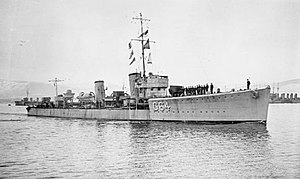
| |
| History | |
|---|---|
| Name | Stonehenge |
| Ordered | 7 April 1917 |
| Builder | Palmers, Jarrow |
| Launched | 19 March 1919 |
| Commissioned | 14 August 1919 |
| Out of service | 6 November 1920 |
| Fate | Abandoned after running aground |
| General characteristics | |
| Class and type | S-class destroyer |
| Displacement | |
| Length | 265 ft (80.8 m) p.p. |
| Beam | 26 ft 8 in (8.1 m) |
| Draught | 9 ft 10 in (3 m) mean |
| Propulsion |
|
| Speed | 36 knots (41.4 mph; 66.7 km/h) |
| Range | 2,750 nmi (5,090 km) at 15 kn (28 km/h) |
| Complement | 90 |
| Armament |
|
HMS Stonehenge was an Admiralty S-class destroyer that served with the Royal Navy during the twentieth century. The S class was a development of the R class created during the First World War as a cheaper alternative to the V and W class. Launched after Armistice that ended the war, the ship was commissioned in 1919 and joined the Fourth Destroyer Flotilla. The vessel supported the Allied intervention in the Russian Civil War and then British forces assisting the partition of the Ottoman Empire, being based at Constantinople in 1920. In that year, the destroyer ran aground off the coast of Smyrna while on a routine mission. Despite attempts by sister ship Serapis to refloat the stricken vessel, Stonehenge had to be abandoned, although no one died in the accident. The remains were sold in 1921.